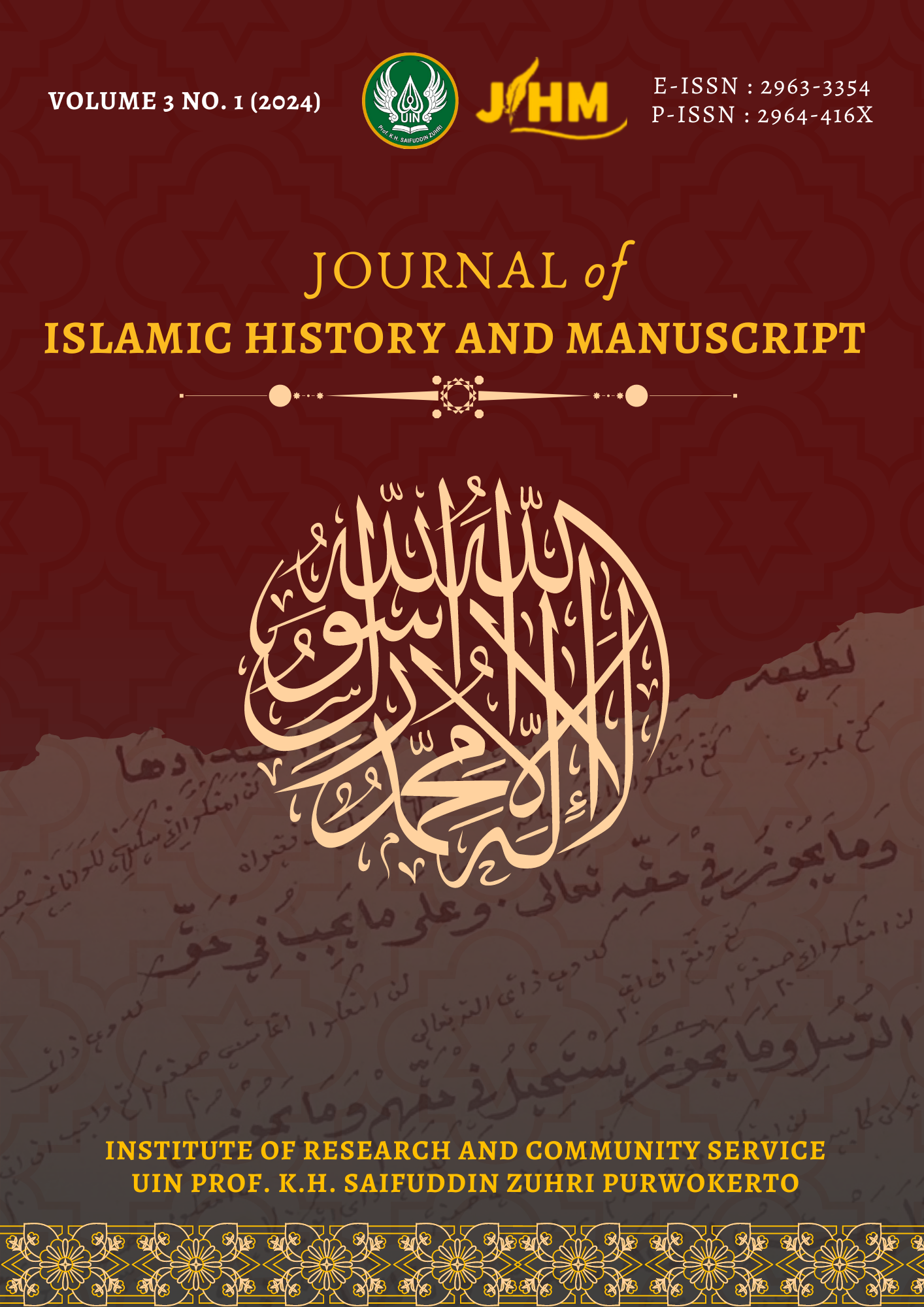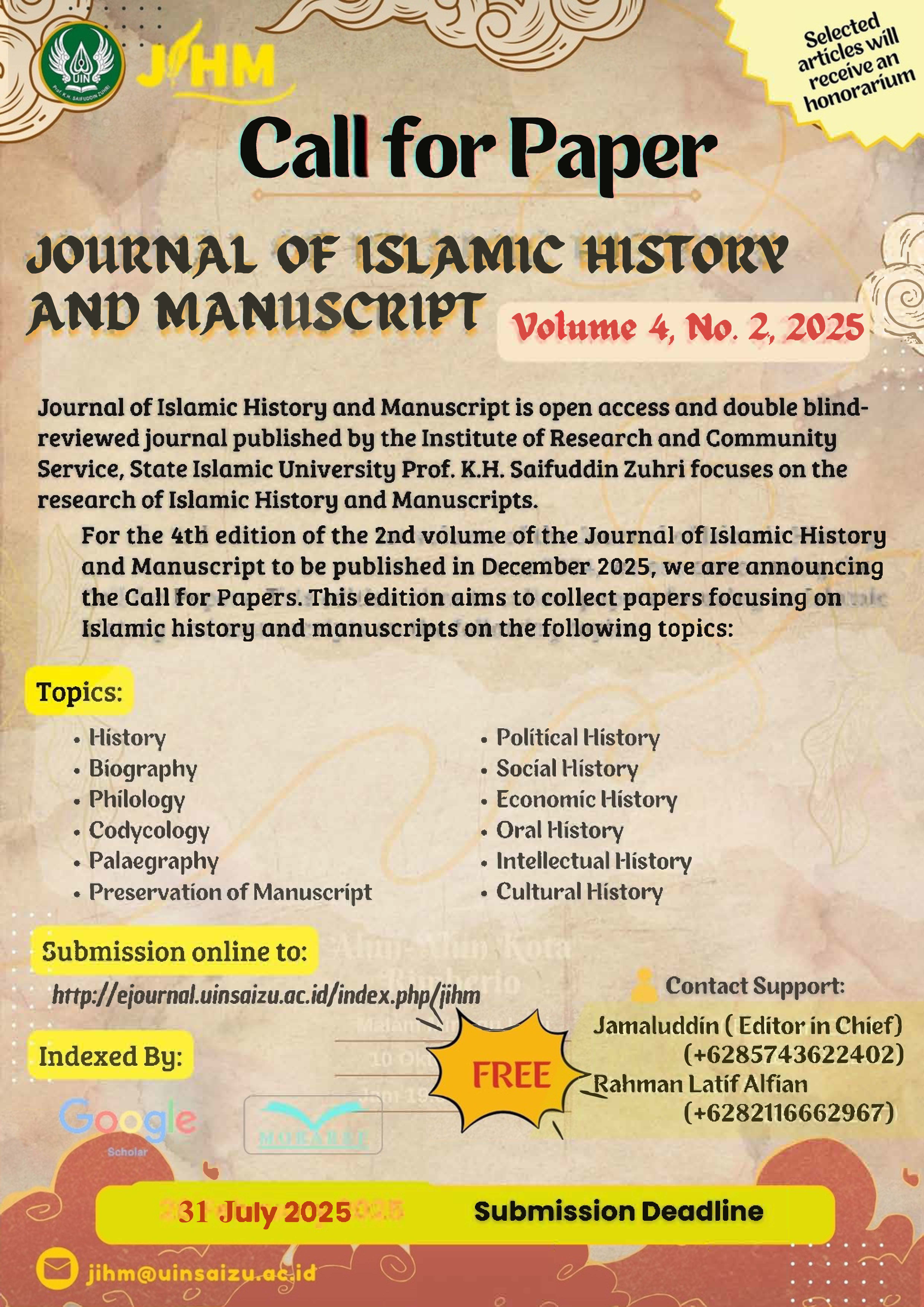The Meaning and Function of Pegon Inscriptions on The First Gate of Bejagung Lor Tomb Complex
DOI:
https://doi.org/10.24090/jihm.v3i1.9368Keywords:
Pegon Inscriptions, Meaning, Function, Bejagung Lor, Sengkalan, TubanAbstract
This study aims to examine the meaning and function of Pegon inscriptions on the first gate of the complex of Sunan Bejagung Lor's Tomb. The Pegon inscriptions are of significant size and contain advice or guidance. This qualitative research is based on a symbolic interactionism approach. Data is collected through interviews, field observations, and literature review. The research reveals that the Pegon inscriptions primarily serve as sengkalan for the numerals at the end of each sentence. They are also perceived as valuable advice by the local community, who view them as the wise words of the sunan. The gate was constructed in 1896 by Tuban regent, Raden Toemenggoeng Koesoemodikdo, not Sunan Bejagung's disciples. This research enriches our understanding of the history and culture of Sunan Bejagung Lor's Tomb and sheds light on the significance of the Pegon inscriptions on the gate.References
Bratakeswara, R., & Hdisoeprapta, T. W. K. (1980). Keterangan Candrasengkala. Balai Pustaka.
Chambert-Loir, Henri., Guillot, C., & Couteau, J. (2007). Ziarah dan wali di dunia Islam. Serambi.
Fajri, A. (2019). Dua Ziarah Agung: Makam Wali sebagai Sumber Otoritas Politik di Dunia Indo-Islam pada Abad ke 16-17. In Kuasa Makna Perspektif Baru dalam Arkeologi Indonesia (pp. 48–87). Departemen Arkeologi FIB UGM.
Irakusuma, R. N. F. (2021). Distribusi dan Makna Partikel Lah dalam Teks Syi’ir Qiyamah Beraksara Pegon: Analisis Sintaksis dan Semantik. Universitas Gadjah Mada.
Kuswanto. (2004). Bentuk Lantiyu: Popularitas dan Fungsinya dalam Arsitektur Islam di Jawa (Sebuah Kajian Awal Pada Bangunan Pintu Gerbang. Desawarnana, 1(1), 12–19.
Muhammad, H. (1986). Qawaidul Khat Al-Arabi. Art Institute.
Nawawi, A. C. (1993). Gaya Khat Arab di Masjid Pencikan dan Situs Makam Ki Ageng Ngerang Daerah Juwana: Tinjauan Berdasarkan Data Arkeohistoris. Berkala Arkeologi, 13(1), 35–51. https://doi.org/10.30883/jba.v13i1.564
Pudjiastuti, T. (2009). Tulisan Pegon: Wujud Identitas Islam-Jawa, Tinjauan atas Bentuk dan Fungsinya. Suhuf, 2(2), 271–284.
Sirojuddin, D., & Nusrog, N. L. (2016). Seni Kaligrafi Islam. Imprint Bumi Aksara.
Soenarto, E. (2005). From Saints to Superheroes: The Wali Songo Myth in Contemporary Indonesia’s Popular Genres. Source: Journal of the Malaysian Branch of the Royal Asiatic Society, 78(2), 33–82. https://about.jstor.org/terms
Suwito, Y. S., Darmosoetopo, R., Nugrahani, D. S., & Albiladiyah, S. I. (2015). Kajian Prasasti dan Sengkalan di Makam dan Masjid Mataram Kotagede. Dinas Kebudayaan DIY.
Tjahyadi, I., Andayani, S., & Wafa, H. (2020). Pengantar dan metode penelitian budaya (A. Sutrisno & N. Hidayati, Eds.; 1st ed.). Pagan Press.
Downloads
Published
How to Cite
Issue
Section
License
Copyright (c) 2024 Siti Nur Aqidatul Izza

This work is licensed under a Creative Commons Attribution 4.0 International License.
Authors who publish in this journal agree to the following terms:
- Authors retain copyright and grant the journal right of first publication with the work simultaneously licensed under a Creative Commons Attribution 4.0 International License. that allows others to share the work with an acknowledgment of the work's authorship and initial publication in this journal.
- Authors can enter into separate, additional contractual arrangements for the non-exclusive distribution of the journal's published version of the work (e.g., post it to an institutional repository or publish it in a book), with an acknowledgment of its initial publication in this journal.
- Authors are permitted and encouraged to post their work online (e.g., in institutional repositories or on their website) before and during the submission process, as it can lead to productive exchanges and earlier and greater citation of published work (See The Effect of Open Access).

















